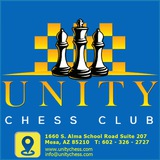"Strategically important points should be overprotected. If the pieces are so engaged, they get their regard in the fact that they will then find themselves well posted in every respect."
🔹 Aron Nimzowitsch
@UnityChess
🔹 Aron Nimzowitsch
@UnityChess
Pasadena, 1932.
(Seated) Alexander Alekhine and Isaac Kashdan. (Standing) Mexican champion José Araiza, Arthur Dake, Reuben Fine and Sammy Reshevsky.
@UnityChess
(Seated) Alexander Alekhine and Isaac Kashdan. (Standing) Mexican champion José Araiza, Arthur Dake, Reuben Fine and Sammy Reshevsky.
@UnityChess
International tournament Moscow, 9th November 1963 round 9. Among the pairings: Gligorić v. Keres, Hort v. Tal, Smyslov v. Balcerowski, Liberzon v. Matanović.
@UnityChess
@UnityChess
📘 25...Re8!
Anish Giri finds the best moves to hold a draw.
26.a3
26.R×e8 Q×e8 27.Q×b7 Nb4 28.Q×a7 Qe2 29.b3 Nd3 with compensation.
26...R×e1+ 27.N×e1 Nb8 28.Nc2 Qe7 29.Qe3 Qe5 =
Anish Giri finds the best moves to hold a draw.
26.a3
26.R×e8 Q×e8 27.Q×b7 Nb4 28.Q×a7 Qe2 29.b3 Nd3 with compensation.
26...R×e1+ 27.N×e1 Nb8 28.Nc2 Qe7 29.Qe3 Qe5 =
📘 14.Bc3!
A Multi-purpose move:
- Clearing the b-file for own rooks.
- Intending Qa3
- Preparing for connection between the rooks.
14...N×d4 15.e×d4 Bf5 16.Qa3 Bd3 17.Rfe1 B×c4 18.N×c4 R×c4 19.Rab1 Qa6 20.Q×a6 b×a6 21.Bb4 R×d4 22.B×e7 Re8 23.Bc5 =
A Multi-purpose move:
- Clearing the b-file for own rooks.
- Intending Qa3
- Preparing for connection between the rooks.
14...N×d4 15.e×d4 Bf5 16.Qa3 Bd3 17.Rfe1 B×c4 18.N×c4 R×c4 19.Rab1 Qa6 20.Q×a6 b×a6 21.Bb4 R×d4 22.B×e7 Re8 23.Bc5 =
📘 22.Nh2?
22.Ng3 Be6 23.Qe3 c5 24.a×b5 a×b5 25.Red1
The correct continuation that Topalov should have played, even though Black's game is more comfortable.
22...B×f5! 23.e×f5 e4! 24.a×b5 a×b5 25.Nf1 c5 26.b3 Nd3 -/+
22.Ng3 Be6 23.Qe3 c5 24.a×b5 a×b5 25.Red1
The correct continuation that Topalov should have played, even though Black's game is more comfortable.
22...B×f5! 23.e×f5 e4! 24.a×b5 a×b5 25.Nf1 c5 26.b3 Nd3 -/+
📘 37... Kh6??
Mamedov made a blunder. He could have obtained a draw by playing 37...Kf6! =
38. Kg3 Rf6
A)38... Rbxf2 39. Rh8+ Kg5 40.h4+ Rxh4 41. Ra5+ Kf6 42. Rf8+
B)38... Rfxf2 39. Rh8+ Kg5 40. h4+ Kf6 41. Rf8+
C)38... Rf3+ 39. Kg4 Rbxf2 40. Rh8#
39. h4 g5 40. Rh8+ Kg6 41. Rg8+ Kf5 42.Rxg5+ Ke6 43. Re5+ Kd6 44. Ra6+ 1-0
Mamedov made a blunder. He could have obtained a draw by playing 37...Kf6! =
38. Kg3 Rf6
A)38... Rbxf2 39. Rh8+ Kg5 40.h4+ Rxh4 41. Ra5+ Kf6 42. Rf8+
B)38... Rfxf2 39. Rh8+ Kg5 40. h4+ Kf6 41. Rf8+
C)38... Rf3+ 39. Kg4 Rbxf2 40. Rh8#
39. h4 g5 40. Rh8+ Kg6 41. Rg8+ Kf5 42.Rxg5+ Ke6 43. Re5+ Kd6 44. Ra6+ 1-0
📕 White has a number of factors in his favor here but his pieces do not co-ordinate too well. Fortunately, this is easily taken care of. The most obvious is the knight, which needs to find a better square. On e6 the knight will completely dominate Black (g7, f8, and d8) and keep the e-file closed, until that very special moment when the knight moves and Black suffers a serious invasion. Therefore we should first improve the advanced rook as it occupies the transit square.
24.Rc6!
Here the rook is now perfectly placed and will be relatively undisturbed because it is on a light square (where White is in control). Already a6 is under pressure, while g6 is also a potential target, and in the meantime, the e6-square is under control.
24...fxe6 25.Nc5 Qf7 26.Nxe6+/-
24.Rc6!
Here the rook is now perfectly placed and will be relatively undisturbed because it is on a light square (where White is in control). Already a6 is under pressure, while g6 is also a potential target, and in the meantime, the e6-square is under control.
24...fxe6 25.Nc5 Qf7 26.Nxe6+/-
📕 This is a really interesting position and difficult to evaluate. Luckily we do not need to do so to find the best move! But anyway, let us resort to one of the old methods of evaluation. Where should the pieces be placed? White, for sure, wants the queen's rook on d1, while the queen could go to d7 or d2 and the bishop – who knows? White needs to somehow break a hole in Black's centre, or forever live with a bad bishop. But in the position White is under attack.
17.Rfb1!
The only move that helps White in his quest to obtain his favorite piece placement. Now the idea is Qg5-d1-d2 followed by f2-f3 and Rb1-d1 (maybe), with Bg3-f2 and b2-b4 in some positions. Less good is 17.Rab1 Qc4!.
17.Rfb1!
The only move that helps White in his quest to obtain his favorite piece placement. Now the idea is Qg5-d1-d2 followed by f2-f3 and Rb1-d1 (maybe), with Bg3-f2 and b2-b4 in some positions. Less good is 17.Rab1 Qc4!.
